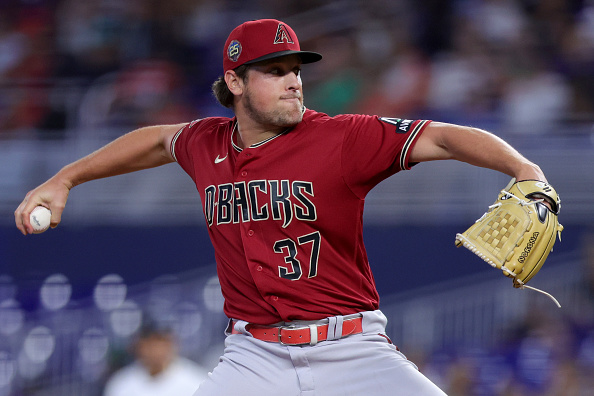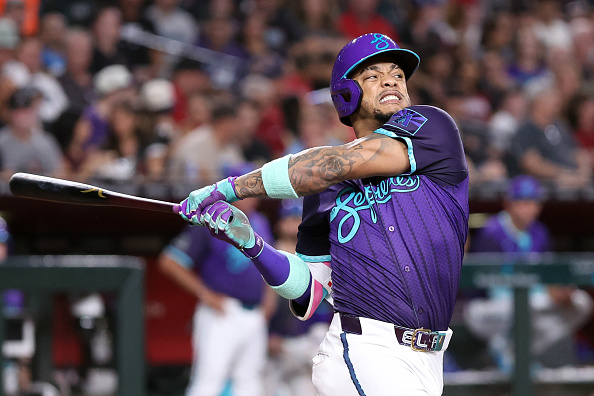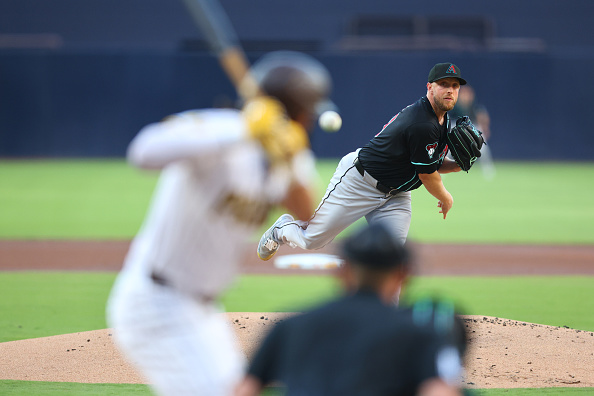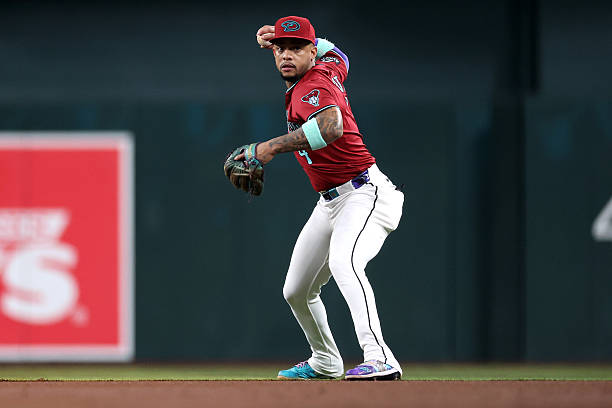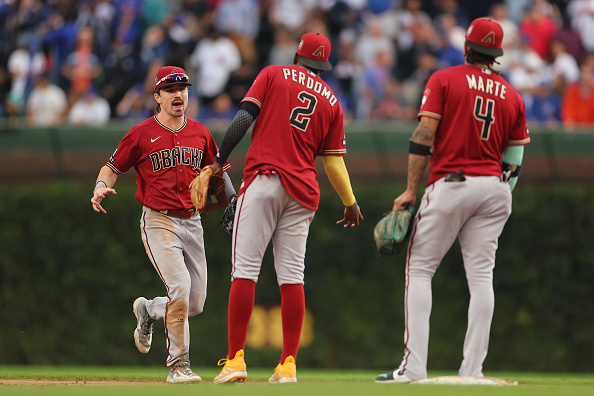Kevin Ginkel and the Arizona Diamondbacks See Perseverance Pay Off
Ever wondered which Arizona Diamondbacks reliever has been with the team the longest? When looking at the active roster, only three were even with the team last season. Two of those three were with the team in 2021. Going back to 2019 leaves only one — Kevin Ginkel. While Andrew Chafin is in his sixth season with the Diamondbacks, he left in 2020 and didn’t come back until this past spring. That leaves Ginkel, in his fifth season with the team, as the one whose current tenure began longest ago.
It is not unusual to see high turnover rates in bullpens. In fact, it is rare to see a reliever stay with one team for long. Ginkel calls the fact that he’s in his fifth season with the team “an accomplishment, especially as a reliever.” He added, “It’s been nice. I hope to continue to be here and be in a key role, be a key cog, in our team’s chances of winning.” Bullpen coach Mike Fetters certainly feels he’s a key cog in the team’s chances of winning, saying simply, “If he pitches well, we win games.”
Early Career of Kevin Ginkel
Kevin Ginkel pitched collegiately at Southwestern College (Chula Vista, California) and the University of Arizona. In his senior year (2016) at Arizona, they finished as the national runner-up to Coastal Carolina. The Diamondbacks selected Ginkel in the 22nd round of the 2016 Amateur Draft. While he obviously would have been thrilled to play anywhere in the majors, he was happy with being drafted by the Diamondbacks. The San Diego native said about being drafted by the Diamondbacks, “I have so much family here. And I’m not too far away from my parents.”
Ginkel worked his way up through the minors, beginning in late 2016. He pitched in the Arizona Fall League in 2018 before hitting Double-A and Triple-A in 2019. While with Triple-A Reno, he tossed 16 2/3 innings across 15 appearances. Thirteen of those appearances were scoreless, a rate of 86.7% (league average is generally 70%). Two of the three runs he allowed came on solo home runs. To be that stingy in run prevention while pitching in the high-elevation environment of Reno is impressive. It earned a major-league callup, and he debuted on August 5 against the Philadelphia Phillies at Chase Field.
Debut Season
Ginkel raised eyebrows immediately. He made 25 relief appearances over the final two months of the 2019 season. In 21 of them, he did not give up an earned run, and in 18, he held opponents completely scoreless. His WHIP was 0.986, and his ERA was 1.48. In addition, opponents batted .174 against him with a 29.2% strikeout rate and 9.4% walk rate. Fans of the Goose Egg statistic will appreciate this nugget — he had 10 Goose Eggs and no broken eggs.
“(Kevin) picked up right where he needed to after having a very successful campaign in Triple-A. He was on a roll — he was on a great roll. We won a lot of baseball games because of him and what he was able to do setting up Archie Bradley,” manager Torey Lovullo said.
“He was lights out,” Fetters said. “And he was confident. All his stuff was working. No one had seen him before. Small sample size, but he was really, really good stuff-wise.”
Growing Pains
Then came 2020, when, as Fetters put it, “the opposing teams started getting reports on him. He didn’t quite have the same success.” Lovullo called it “growing pains,” something he said “all young pitchers go through.” Lovullo added, “Maybe a little bit of the perfectionist in him came out. And that led to some frustration.” Opponents batted .318 against Ginkel in the 2020 season with a 22.8% strikeout rate, a 16.5% walk rate, and a 2.125 WHIP in 16 innings.
The following season did not go well for Ginkel, either, although it was an improvement over 2020. His walk rate dropped from 2020 — 16.5% to 10.9% — as his strikeout rate went up, from 22.8% to 24.0%. However, his home run rate jumped from 3.8% to 5.4%. Opponents batted .268 against him, contributing to a 1.553 WHIP. Although the WHIP was an improvement over 2020, it still was too high. These factors culminated in Ginkel being optioned to Triple-A Reno in June. It turned out, however, that he had right elbow inflammation. This landed him on the 60-day IL after one minor-league game.
These two seasons helped Ginkel grow, both as a player and a person. “(They) allowed me to realize that I can’t control all the results,” he said. “Going through tough times builds character and mental toughness. I’m proud that I did do that, because I feel like I’m a way different pitcher now than I was early on, where I was seeing a lot of success. Teams adjust to you and stuff, but I know who I am. I know what my strengths are. And I’m proud of how I responded.”
Help through the Obstacles
Fetters said he “always knew (Ginkel) had the stuff. It was just a matter of whether he was going to be able to mentally make his adjustments. Don’t give guys too much credit, like any young pitcher would. The whole time, (I tried to) make him realize, ‘You’re better than those guys. You don’t have to worry about scouting — you gotta go with your best stuff.’ He’s a guy that has to pitch to his strengths and not to the weaknesses of a hitter, because he has a better strength than their weakness.”
Ginkel credits Fetters with helping get him through the adverse times. “(Fett is) someone who’s been through this,” Ginkel said of the retired 16-year major league veteran. “He’s been a reliever his whole career. And I definitely think he believes in me — and obviously I believe in myself — but he has been a huge component of that.”
Another coach who stuck with Ginkel “through the ups and downs,” as he put it, is assistant pitching coach Barry Enright. “He’s been helpful with juggling thoughts and ideas in how to attack guys.” Ginkel credits both with helping him develop his “form” as he’s progressed through his career.
Return to the Majors
Diamondbacks relievers, as a unit, were historically bad in 2021. Not surprisingly, few who started 2021 with the team even made it through the season, let alone came back in 2022. But the Diamondbacks stuck with Ginkel. He feels that his adversity and how he reacted to it has helped his standing with the organization. “I’ve gone through some injuries and some struggles, but they’ve seen me be really good,” Ginkel said. “They’ve seen me be really good, and they’ve seen me work through that.”
Kevin Ginkel returned to play April 7, 2022, with a 1–2–3 ninth inning and save for the Triple-A Reno Aces on the road against the Las Vegas Aviators. It was the first step toward a brilliant 30-game stretch. In 30 2/3 innings, Ginkel allowed a grand total of six runs, four of which were earned. He faced 123 batters total, striking out 45 (36.6%) while walking 12 (9.8%) and allowing one home run (0.8%). His WHIP was 1.141. Of his 30 appearances, 25 were scoreless — 83.3%. It was time for him to return to the majors, and the Diamondbacks called him up for their August 1 game at the Cleveland Guardians.
Ginkel made 30 appearances in 2022 with the Diamondbacks as well, mostly in either the sixth or seventh inning. Across 29 1/3 innings, Ginkel faced 124 batters, striking out 30 (24.2%, NL avg 22.6%) while walking 11 (8.9%, NL avg 8.3%) and surrendering one homer (0.8%, NL avg 2.9%). In addition, he had a 1.295 WHIP, and 24 of his 30 appearances were scoreless — 80.0%, nearly 11 points higher than the NL average of 69.3%.
Current Season
Kevin Ginkel is now a key middle reliever for the 2023 Diamondbacks. Of his 15 appearances, 11 were scoreless — 73.3%, nearly four points higher than the NL average of 69.3%. His WHIP is higher than he would like — 1.463, when the league average is 1.345 — and his strikeout (17.0%, 22.5% NL avg) and walk (11.9%, NL avg 8.9%) rates could also use improvement. But his home run rate (1.7%) is slightly more than half (3.0%) of the league average.
Pitching coach Brent Strom said, “It’s a confidence thing with Kevin.” Strom went on to describe some weapons he likes from Ginkel’s arsenal. “I was enamored with his breaking ball when I first ran into him in a bullpen session…. He has a plus-plus breaking ball. This guy really gets on a roll, gets his confidence and everything, he can be a frontline reliever. He has two swing-and-miss pitches. Love the guy.”
Ginkel said of Strom, “He’s been tremendous for me. I think he adds a sort of calmness about how I’m pitching. If I need a mound visit, he comes out and says the right things and helps me get my focus back. He just simplifies his message. Obviously, he’s one of the best pitching coaches in the league, so I’ve got a ton of respect for him. He’s helped me go through some mechanical changes, as well, that have been so helpful for me. They help me get strikes and pitch ahead. We’ve gone to work over the past year or so working on mechanical stuff and mental stuff. It’s been really nice.”
The Future for Kevin Ginkel
Now that Ginkel has learned what Fetters described about pitching to his strengths rather than his opponents’ weaknesses, Fetters feels he’s “turned the corner.” After explaining how the pitch clock has made Ginkel hold runners differently, Fetters said, “The little parts of the game he had to get better at, he’s gotten better at. The bottom line is, when he pitches well, we win.”
Ginkel’s performance, in the eyes of Fetters, contributes heavily to the overall performance of the relief corps. “In the past,” Fetters put it frankly, “our bullpen hasn’t been so good. And when we haven’t been so good, we lost games we probably should have won. We probably would had way better records than we’ve had in the last couple of years. And he’s a big part of that. He’s a big part of ‘if he pitches well, we win games,’ and he knows that.
“Right now, the leverage situations are ‘middle’ for him. As he continues to get that confidence going, he’ll probably be pitching more in higher level situations. But right now, he’s doing his job, where he’s fitting in right now.
Lovullo said of Ginkel’s return, “It’s been a story of perseverance. A story of him being able to believe in himself through some very trying times where the ball wasn’t coming out the way he wanted it to and the secondary stuff wasn’t landing the way he wanted it to. But he accepted some coaching. He worked his butt off, and everything was trending in a very good direction. He’s showing the form that we remember back in ’19. I don’t want him to be anything other than what he is right now. Continue progressing and learning. He’s doing a great job of that.”
More Arizona Diamondbacks Articles
More MLB Articles
Main Photo:
- Category
-
Arizona Diamondbacks

